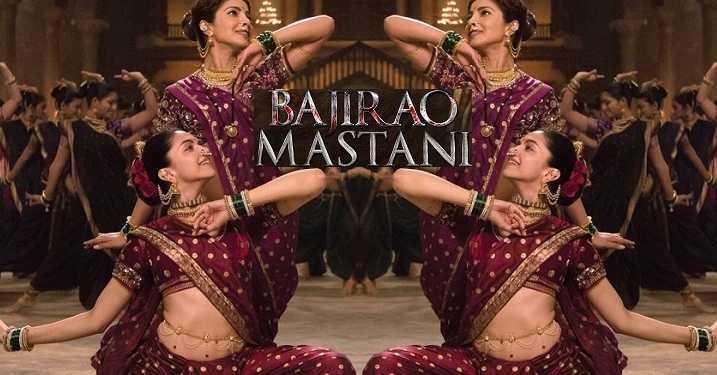
Bhansali makes the Peshwa Queen perform Pinga ga pori like a courtesan
There is hardly any doubt that Sanjay Leela Bhansali wanted the song Pinga ga pori Pinga to be his piece de resistance. Something that movie goers would remember him for years to come. People would talk of flawless sets, optimum lighting, perfect attire, glittering jewellery and the ultimate dance put up by Priyanka and Deepika. It was supposed to be the perfect combination of artistic blitz, ostentation and rich Indian culture of yore. The story of the great Peshwa Baji Rao I and his courtesan, Mastani, provided Bhansali the perfect opportunity to recreate that magic. After all, Bhansali specializes in bringing to life stories that involve Love triangles(remember Devdas). Tragically, Pinga ga Pori Pinga is so full of glaring discrepancies and obtrusive shortcomings that it will probably be
forgotten in a matter of weeks, if not days. A portion of the imperfection obviously stems from Bhansali neglecting to read the history and doing proper research on the era, which is especially calamitous, given that BajiRao Mastani is supposed to be a period film, but a bigger portion of the failure stems from Bhansali’s pitiable attempt to Bollywood-ize an important part of our historical heritage.
1. The History
Peshwa Baji Rao I, his wife Kashibai and Mastani were all real historical characters. They are not a part of mythological stories that can be recreated by Film makers the way they choose to. The characters of this story were all alive in the first half of 1700s, that is around 300+ years ago. We have a treasure trove of information on who these people were, how they lived, how they spoke. In reality, so many of the traditions that were followed back then are still alive now, which give us a way of peeping into history. Baji Rao I a.k.a. Thorle Bajirao for starters, was one of the greatest Peshwas who ever lived. He is reputed to have fought and never lost 41 battles during his lifetime, during which he extended Maratha control right up to the Mughal capital of Delhi. Not much is known about her first wife, Kashibai, but it is believed that she lived as was expected of a Queen during those times. It is also believed she had a limp, making it difficult for her to walk upright. Accounts point towards her having been an ideal wife. Mastani, by various accounts, is believed to either the daughter of Bundeli Raja Chhatrasal, or the daughter of Nizam of Hyderabad and was married to the Peshwa, which earned them the wrath of the court, who tended to look at Mastani as a mere courtesan. She is believed to be exceptionally beautiful and brave and accompanied the Peshwa on his battles. Upon hearing of the Peshwa’s death in 1740, she is believed to have committed suicide either by Sati or by drinking poison. Mastani was Pehswa’s lawfully wedded wife and bore him a son, who was brought up by Kashibai after her death. Kashibai’s greatness is demonstrated by the fact that she bore no ill will towards her husband’s other wife, or her son. Sanjay Leela Bhansali reduces this complex relationship between the Peshwa and his two wives to a simple Love triangle, with song and dance, something that was not a part of societal customs of the time.
2. The Society
The Peshwas were Chitpavan Konkanastha Brahmins, who had been appointed Peshwa (Prime Minister) by the Chhatrapati, who was the Supreme Maratha sovereign. The Peshwas followed all cultural mores that were expected from them. In fact, Chitpavan Konkanastha Brahmins considered themselves at the top of the social hierarchy, ahead of other Brahmin castes, something that was always strongly contested. This was an era, when it would be unusual for a Deshastha Brahmin (another Maharashtrian Brahmin group) and Konkanastha Brahmin to even interdine, even though the two belonged to the same caste in the social hierarchy. As a community, they were expected to be conservative and uphold ancient Hindu rites and rituals. Similarly, the Peshwa Queen was expected to be draped completely from head to toe, in a 9 yard Saaree, called Nauvari. This was draped in what is today known as Brahmani style. The Peshwa Queen was expected to be formal and stiff in public appearances. There was hardly any concept of singing and dancing in the public, not even with the royal ladies, save religious ceremonies, much less with courtesans. On these two accounts, Sanjay Leela Bhansali has committed fatal errors. Priyanka and Deepika are decked in the most beautiful nauvaris, but they are not worn in Brahmani style. They are worn in what is colloquially known as the Maratha style. Peshwa Queens could never have worn Nauvaris in this style. Also, the amount of skin showing by Deepika and Priyanka during Pinga ga Pori pinga, was probably even more than that would be done by dancers in that era. Sanjay Leela Bhansali, in one song has reduced both wives of the great Thorle Baji Rao to common nautch girls. History tells us that Kashibai met Mastani only once, and that too formally, which would be expected.
3. Pinga ga Pori Pinga- The Song and the Dance
Peshwa society had a history of song and dance that was performed during festivals. These are typically slow moving songs that feature delicate hand and leg movements to maintain propriety but still have some fun. Pinga Ga pori Pinga is definitely not a part of this culture. It barely sounds like a Marathi song, let alone a song that would resemble the traditions of the Chitpavan community. It is a kitschy remake of several traditional Marathi songs sung during festivals, songs sung during Lavani (the folk song and dance of Maharashtra, featuring erotic moves and double entendres) and the typical Bollywood songs of our era. It sounds jarring to the ear and is as far removed from mellifluous Marathi songs sung during festive times, which would probably witness the participation of Peshwa ladies. Deepika and Priyanka are seen gyrating to the tunes of this Bollywood number in a faux-Lavani style that combines all of Lavani’s whirling but none of its delicate movements. Priyanka is still able to maintain some grace in her moves, but Deepika stands tall, almost like a brick minaret, devoid of expressions. Her moves are robotic, her eyes blank and it seems that she is going through the dance routine to just it get it off her back. The link here is an indication of the song and dance in Peshwa household in that era would have been. Compare this with the loud and tawdry Pinga ga Pori Pinga song and dance show in Sanjay Leela Bhansali’s so-called epic. All this, without even getting started on how Pinga ga pori Pinga is simply Dola re dola in a marathi-esque attire!
The greatest tragedy about the song and the movie is that lakhs of moviegoers will see the film, without having any knowledge of the real history that “inspired” the film and will believe the film to be the real version of the history. They will reduce a glorious portion of our history, an era that saw the rise of the great Maratha Empire to bawdy song and dance, assume that the great Baji Rao I was a mere womanizer and believe that the Peshwa queens of yore were nothing more than common nautch girls. What a terrible way to remember the memory of our great ancestors!!
References:
http://www.huffingtonpost.in/2015/11/16/pinga-bajirao-mastani_n_8573428.html
http://www.dnaindia.com/entertainment/report-pinga-controversy-bajirao-s-descendant-hits-out-at-sanjay-leela-bhansali-2146623


































